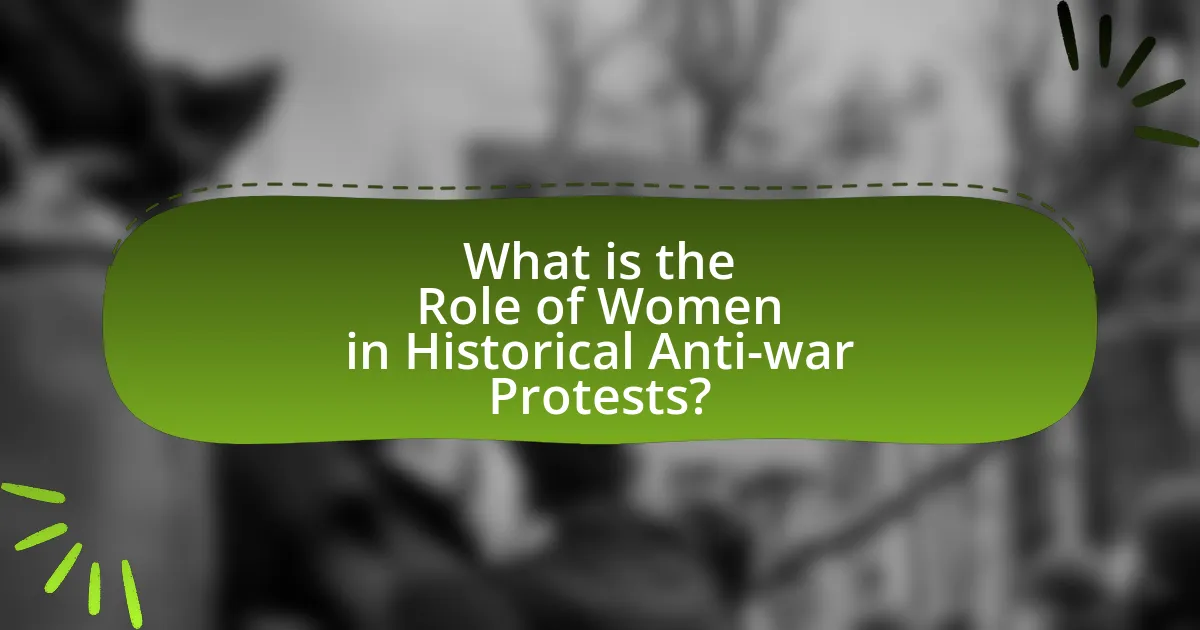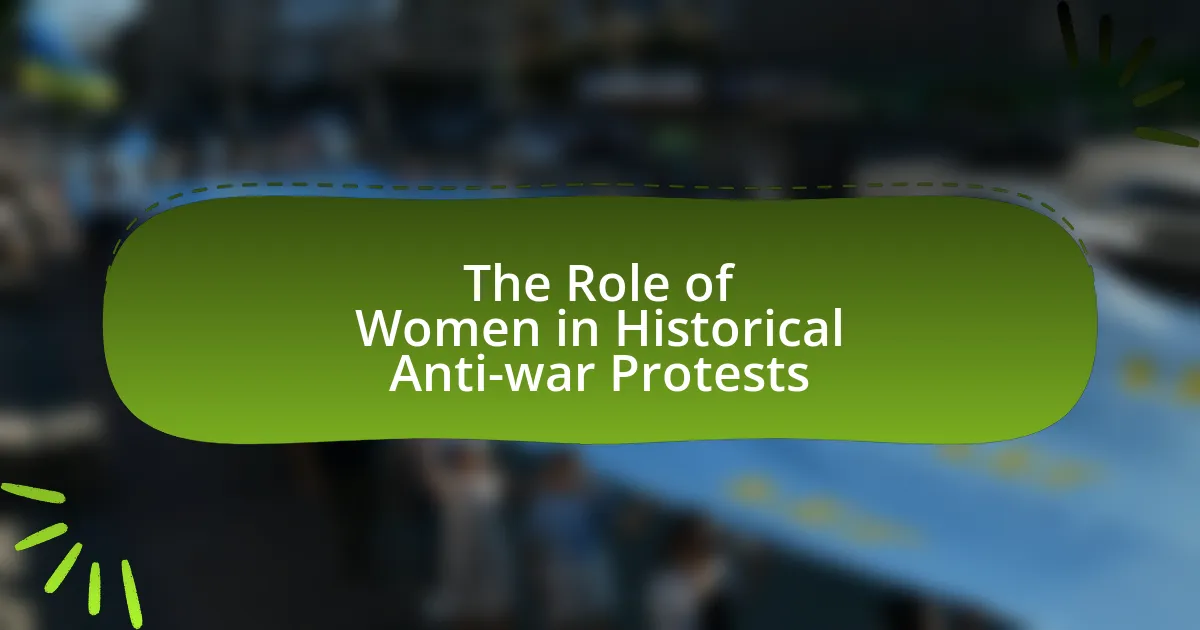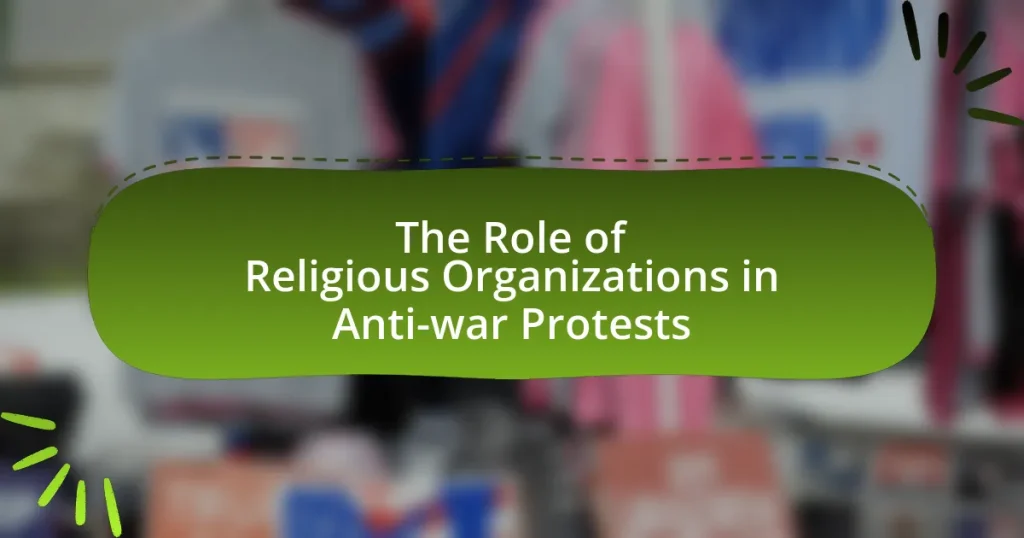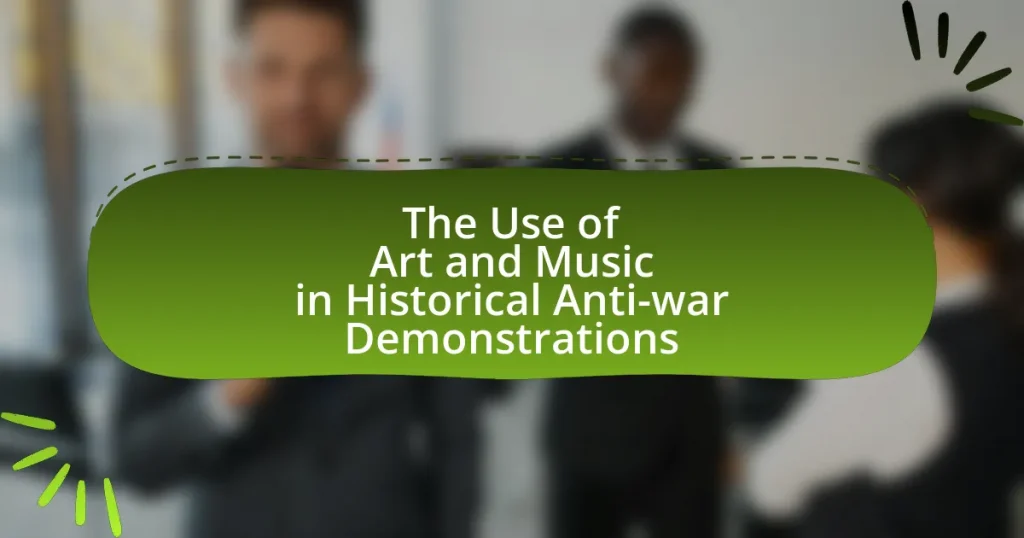The article examines the significant role of women in historical anti-war protests, highlighting their contributions as organizers, activists, and advocates for peace across various conflicts, including World War I, World War II, and the Vietnam War. It details specific events that showcase women’s involvement, such as the Women’s Peace March in 1969 and the Women’s International League for Peace and Freedom, emphasizing how women’s activism has evolved over time and influenced public perception and policy regarding war. The article also discusses the challenges women faced within these movements and the lasting impact of their activism on contemporary anti-war efforts, underscoring the importance of recognizing and supporting women’s voices in the ongoing struggle for peace.

What is the Role of Women in Historical Anti-war Protests?
Women have played a crucial role in historical anti-war protests, often serving as key organizers, activists, and voices for peace. Throughout various conflicts, such as World War I, World War II, and the Vietnam War, women mobilized communities, led demonstrations, and utilized creative forms of protest, including art and literature, to advocate against war. For instance, during the Vietnam War, groups like the Women’s International League for Peace and Freedom and the Vietnam Veterans Against the War saw significant female participation, highlighting women’s unique perspectives on the impacts of war on families and society. Their involvement not only challenged traditional gender roles but also contributed to broader social movements, emphasizing the importance of women’s voices in advocating for peace and justice.
How have women contributed to anti-war movements throughout history?
Women have significantly contributed to anti-war movements throughout history by organizing protests, advocating for peace, and influencing public opinion. For instance, during World War I, women formed groups like the Women’s Peace Party in the United States, which aimed to promote peace and negotiate an end to the war. Additionally, women played a crucial role in the anti-Vietnam War movement in the 1960s, with organizations such as the Women’s International League for Peace and Freedom mobilizing protests and raising awareness about the war’s impact on civilians. Their efforts have often highlighted the humanitarian consequences of conflict, thereby shaping the discourse around war and peace.
What specific events highlight women’s involvement in anti-war protests?
Specific events that highlight women’s involvement in anti-war protests include the Women’s Peace March in 1969, where thousands of women gathered in Washington, D.C., to oppose the Vietnam War. Additionally, the Women’s International League for Peace and Freedom, founded in 1915, played a significant role in organizing protests and advocating for peace during various conflicts. The 1982 March for Peace in New York City, which saw a large contingent of women participating, further exemplifies women’s activism against war. These events demonstrate the critical role women have played in anti-war movements throughout history.
How did women’s roles evolve in these movements over time?
Women’s roles in historical anti-war protests evolved from passive supporters to active leaders and organizers. Initially, women participated primarily in supportive roles, such as providing logistical assistance and mobilizing communities. Over time, particularly during the Vietnam War era, women began to take on more prominent roles, forming their own organizations like the Women’s International League for Peace and Freedom, which advocated for peace and disarmament. This shift was evidenced by the significant participation of women in large-scale protests, where they not only contributed to the movement but also articulated their own perspectives on war and peace, influencing public discourse. By the late 20th century, women’s involvement in anti-war movements had become integral, with many women emerging as key figures in leadership positions, demonstrating their capacity to shape the direction and strategies of these movements.
Why is it important to study women’s contributions to anti-war protests?
Studying women’s contributions to anti-war protests is important because it highlights the significant role women have played in shaping social movements and influencing public policy. Women have historically been at the forefront of anti-war activism, organizing protests, and advocating for peace, as seen in movements like the Women’s Peace Party during World War I and the Women’s International League for Peace and Freedom. Their involvement not only challenges traditional narratives that often overlook female participation but also provides a more comprehensive understanding of the dynamics of social change. Research indicates that women’s activism has led to more inclusive and effective peace initiatives, demonstrating that their perspectives are crucial in addressing the complexities of war and conflict.
What impact did women’s activism have on public perception of war?
Women’s activism significantly shifted public perception of war by highlighting its human costs and advocating for peace. Through organized protests, such as the Women’s Peace Party founded in 1915, women brought attention to the suffering caused by conflict, which resonated with broader audiences. Their efforts, exemplified by the 1915 International Congress of Women in The Hague, emphasized diplomacy over militarism, influencing public discourse and policy. This activism contributed to a growing anti-war sentiment, particularly during World War I and subsequent conflicts, as women’s voices became integral in framing war as a moral issue rather than a political necessity.
How did women’s participation influence policy changes regarding war?
Women’s participation significantly influenced policy changes regarding war by mobilizing public opinion and advocating for peace through organized protests and activism. For instance, during the Vietnam War, women played a crucial role in anti-war movements, exemplified by the Women’s Strike for Peace in 1961, which brought together thousands of women to demand an end to nuclear testing and military intervention. This grassroots activism pressured policymakers to reconsider military strategies and prioritize diplomatic solutions, ultimately contributing to shifts in U.S. foreign policy. Additionally, women’s voices in these movements highlighted the human cost of war, leading to increased public awareness and support for peace initiatives, which further influenced legislative changes aimed at reducing military engagement.
What challenges did women face in anti-war movements?
Women faced significant challenges in anti-war movements, including societal gender norms, marginalization within the movements, and violence or harassment. Societal gender norms often relegated women to supportive roles rather than leadership positions, limiting their influence and visibility. Additionally, women frequently encountered marginalization from male counterparts who dominated the discourse and decision-making processes, undermining their contributions. Historical instances, such as the Women’s Peace Party founded in 1915, illustrate how women struggled for recognition and respect in a predominantly male-led anti-war landscape. Furthermore, women activists often faced violence or harassment, both from opposing groups and within their own movements, which created an environment of fear and intimidation that hindered their participation and activism.
How did societal norms affect women’s activism during these protests?
Societal norms significantly influenced women’s activism during these protests by both constraining and motivating their participation. Traditional gender roles often relegated women to domestic spheres, limiting their public engagement; however, the urgency of anti-war sentiments prompted many women to challenge these norms. For instance, during the Vietnam War protests, women organized events like the Women’s Strike for Peace in 1961, which highlighted their unique perspectives on war and peace, thereby reshaping societal expectations. This activism not only expanded the role of women in public discourse but also laid the groundwork for future feminist movements, demonstrating that societal norms could be both a barrier and a catalyst for women’s activism.
What forms of resistance did women encounter from within the movements?
Women encountered significant resistance from within anti-war movements, primarily manifested through gender bias, exclusion from leadership roles, and dismissal of their contributions. Historical accounts indicate that male leaders often prioritized traditional masculine perspectives, sidelining women’s voices and issues. For instance, during the Vietnam War protests, women activists faced skepticism regarding their commitment and capabilities, leading to their marginalization in decision-making processes. This resistance was evident in organizations like the Students for a Democratic Society, where women’s participation was often minimized despite their active involvement. Such dynamics illustrate the internal challenges women faced while striving for recognition and equality within these movements.
How did different historical contexts shape women’s anti-war activism?
Different historical contexts significantly shaped women’s anti-war activism by influencing their motivations, methods, and public perceptions. For instance, during World War I, women in the suffrage movement leveraged their activism against the war to highlight their fight for voting rights, as seen in organizations like the Women’s Peace Party founded in 1915. In contrast, during the Vietnam War, women such as those in the Women’s International League for Peace and Freedom utilized grassroots organizing and protests to challenge militarism, reflecting the broader civil rights and feminist movements of the 1960s. These contexts not only provided unique platforms for women’s voices but also framed their activism within the larger societal issues of their times, demonstrating how historical events and social movements directly influenced women’s roles in anti-war efforts.
What role did the suffrage movement play in anti-war protests?
The suffrage movement significantly influenced anti-war protests by linking women’s rights to broader social justice issues, including peace. Activists like Jane Addams and the Women’s Peace Party argued that women’s participation in public life and decision-making was essential for promoting peace and preventing war. Their efforts highlighted the moral imperative of women in advocating for non-violence, as seen during World War I when many suffragists organized protests against the war, emphasizing the need for diplomacy over military action. This connection between suffrage and anti-war activism underscored the belief that women’s perspectives were crucial in shaping a more peaceful society.
How did women’s voting rights influence their participation in anti-war efforts?
Women’s voting rights significantly enhanced their participation in anti-war efforts by empowering them to voice their opinions and influence public policy. After gaining the right to vote in the early 20th century, women became more politically active and organized, leading to increased involvement in movements such as the Women’s Peace Party, founded in 1915. This organization, along with others, mobilized women to advocate against militarism and war, demonstrating their capacity to shape political discourse. Historical evidence shows that women’s suffrage movements laid the groundwork for their engagement in broader social issues, including peace activism, as they utilized their newfound political power to challenge war policies and promote peace initiatives.
What connections existed between suffrage and anti-war activism?
Suffrage and anti-war activism were interconnected through shared goals of social justice and women’s rights. Many suffragists opposed militarism and war, arguing that women’s participation in the political sphere was essential for promoting peace. For instance, organizations like the Women’s Peace Party, founded in 1915, included prominent suffragists such as Jane Addams, who believed that women’s voting rights would lead to more pacifist policies. Additionally, the anti-war movement often highlighted the moral implications of war, aligning with the suffragist perspective that women, as nurturers, had a unique role in advocating for peace. This synergy was evident during World War I, when suffragists actively campaigned against the war, emphasizing that their voices were crucial in shaping a more peaceful society.
How did the Vietnam War impact women’s anti-war movements?
The Vietnam War significantly galvanized women’s anti-war movements by increasing their visibility and activism in the broader peace movement. Women, who were often marginalized in political discourse, took on leadership roles and organized protests, such as the Women’s Strike for Peace in 1961, which highlighted the intersection of gender and war. This movement not only challenged traditional gender roles but also brought attention to issues like militarism and nuclear disarmament, leading to a more inclusive anti-war narrative. The participation of women in these movements contributed to the feminist movement, as they advocated for peace while simultaneously fighting for women’s rights, thus reshaping societal perceptions of women’s roles in both war and peace.
What organizations were formed by women during the Vietnam War era?
During the Vietnam War era, women formed several significant organizations, including the Women’s International League for Peace and Freedom (WILPF) and the Vietnam Veterans Against the War (VVAW) Women’s Caucus. WILPF, established in 1915, saw increased activism during the Vietnam War, advocating for peace and disarmament. The VVAW Women’s Caucus emerged in the late 1960s, focusing on the experiences of women veterans and their opposition to the war. These organizations played crucial roles in mobilizing women for anti-war protests and promoting peace initiatives.
How did women’s experiences in the Vietnam War shape their activism?
Women’s experiences in the Vietnam War significantly shaped their activism by highlighting the injustices and inequalities they faced, which propelled them into leadership roles in anti-war movements. Many women served as nurses, support staff, and activists, witnessing the devastating effects of war firsthand, which fueled their desire for peace and social justice. For instance, organizations like the Women’s International League for Peace and Freedom gained momentum as women shared their experiences and advocated for an end to the conflict, emphasizing the need for a more equitable society. This activism was further evidenced by the formation of groups such as the Vietnam Veterans Against the War, where women played crucial roles in organizing protests and raising awareness about the war’s impact on both soldiers and civilians.
What lessons can be learned from women’s historical anti-war activism?
Women’s historical anti-war activism teaches the importance of grassroots organizing and coalition-building in effecting social change. For instance, the Women’s Peace Party, founded in 1915, mobilized women across various backgrounds to advocate for peace during World War I, demonstrating that collective action can amplify voices and influence policy. Additionally, the anti-nuclear movement in the 1980s, led by women such as those in the Women’s International League for Peace and Freedom, highlighted the effectiveness of nonviolent protest and civil disobedience in raising awareness and challenging militarism. These examples illustrate that women’s activism has historically been pivotal in shaping public discourse around war and peace, emphasizing the need for inclusive participation in peace movements.
How can contemporary movements draw inspiration from past women’s activism?
Contemporary movements can draw inspiration from past women’s activism by adopting strategies and frameworks that have historically proven effective in advocating for peace and social justice. For instance, the Women’s Peace Party, founded in 1915, utilized grassroots organizing and public demonstrations to influence policy during World War I, showcasing the power of collective action. Additionally, the anti-war protests led by women during the Vietnam War highlighted the importance of personal narratives and emotional appeals in mobilizing public sentiment against conflict. These historical examples illustrate that contemporary movements can leverage similar tactics, such as community engagement and storytelling, to resonate with broader audiences and drive change.
What strategies were effective for women in historical anti-war protests?
Effective strategies for women in historical anti-war protests included grassroots organizing, coalition-building, and the use of nonviolent direct action. Women often mobilized local communities through grassroots efforts, creating networks that facilitated communication and collaboration among diverse groups. For instance, during the Vietnam War, organizations like the Women’s International League for Peace and Freedom played a crucial role in uniting women from various backgrounds to advocate against the war. Additionally, women utilized coalition-building to align with other social movements, such as civil rights and labor rights, amplifying their voices and increasing their impact. Nonviolent direct action, exemplified by protests, sit-ins, and marches, allowed women to visibly challenge war policies and draw public attention to their cause, as seen in the 1968 Women’s Strike for Peace. These strategies collectively enhanced the effectiveness of women’s participation in anti-war movements throughout history.
What are the lasting effects of women’s involvement in anti-war protests?
Women’s involvement in anti-war protests has led to significant lasting effects, including the advancement of gender equality in social movements and the shaping of public discourse around war and peace. Historically, women’s participation in protests, such as the Vietnam War demonstrations in the 1960s, challenged traditional gender roles and highlighted women’s voices in political activism. This involvement not only mobilized women to advocate for peace but also fostered a broader understanding of the intersectionality of war, gender, and social justice. Research indicates that the visibility of women in these movements has contributed to ongoing advocacy for women’s rights and has influenced policy changes regarding military engagement and conflict resolution. For instance, the inclusion of women in peace negotiations has been recognized as essential for sustainable peace, as evidenced by United Nations Security Council Resolution 1325, which emphasizes the importance of women’s participation in peace and security efforts.
How has women’s activism influenced modern anti-war movements?
Women’s activism has significantly influenced modern anti-war movements by emphasizing peace, social justice, and community engagement. Historically, women have played pivotal roles in anti-war efforts, such as the Women’s Peace Party founded in 1915, which advocated for disarmament and peaceful conflict resolution. This legacy continues today, as organizations like Code Pink mobilize women to challenge militarism and advocate for diplomatic solutions. Research indicates that women’s participation in peace movements often leads to more inclusive and effective advocacy, as seen in the 2017 Women’s March, which highlighted anti-war sentiments alongside other social issues. The integration of women’s perspectives has thus reshaped the narrative and strategies of contemporary anti-war activism, making it more holistic and intersectional.
What parallels can be drawn between historical and contemporary women’s activism?
Historical and contemporary women’s activism share key parallels in their focus on social justice, community organizing, and the use of grassroots mobilization. Both movements have emphasized the importance of collective action to challenge systemic inequalities, as seen in the suffragette movement of the early 20th century, which fought for women’s voting rights, and today’s women’s marches advocating for reproductive rights and gender equality. Additionally, both historical and modern activists have utilized similar strategies, such as protests, petitions, and public awareness campaigns, to amplify their messages and influence policy changes. For instance, the Women’s Peace Party founded during World War I aimed to promote peace and disarmament, paralleling today’s activists who advocate against militarization and for global peace initiatives. These similarities highlight a continuous thread of women’s activism that adapts to the socio-political context while maintaining core objectives of equity and justice.
How do current anti-war movements honor the contributions of women from the past?
Current anti-war movements honor the contributions of women from the past by actively recognizing and amplifying their historical roles in peace activism. For instance, movements often highlight figures such as Jane Addams, who was instrumental in founding the Women’s International League for Peace and Freedom in 1915, emphasizing her advocacy for disarmament and social justice. Additionally, contemporary protests frequently incorporate feminist perspectives, showcasing how women’s experiences and voices shape anti-war narratives. This acknowledgment not only pays tribute to the legacy of women like Addams but also reinforces the ongoing relevance of their contributions in today’s fight against militarism and violence.
What practical steps can be taken to support women’s roles in current anti-war efforts?
To support women’s roles in current anti-war efforts, organizations can implement targeted training programs that empower women with leadership skills and advocacy techniques. Research indicates that women’s participation in peace processes leads to more sustainable outcomes; for instance, a study by the United Nations found that peace agreements are 35% more likely to last at least 15 years when women are involved. Additionally, providing platforms for women to share their experiences and perspectives can amplify their voices in anti-war movements, fostering greater inclusivity and representation. Financial support for women-led initiatives and campaigns can also enhance their impact, as evidenced by the success of organizations like Women’s International League for Peace and Freedom, which has historically mobilized women for peace advocacy.
How can organizations ensure women’s voices are heard in anti-war activism today?
Organizations can ensure women’s voices are heard in anti-war activism today by actively promoting gender-inclusive platforms and leadership roles within their structures. Research indicates that women’s participation in peace processes leads to more sustainable outcomes; for instance, a study by the United Nations shows that peace agreements are 35% more likely to last for at least 15 years when women are involved in the negotiation process. By creating spaces for women to share their experiences and perspectives, organizations can amplify their contributions and foster a more comprehensive dialogue on anti-war initiatives. Additionally, implementing training programs that empower women in advocacy and public speaking can further enhance their visibility and influence in activism.
What resources are available for women looking to engage in anti-war movements?
Women looking to engage in anti-war movements can access various resources, including organizations, literature, and online platforms. Notable organizations such as Women’s International League for Peace and Freedom (WILPF) provide networking opportunities, educational materials, and advocacy tools specifically aimed at women. Additionally, literature such as “Women and War: A Historical Encyclopedia from Antiquity to the Present” offers insights into women’s roles in anti-war efforts, while online platforms like social media groups and websites dedicated to peace activism facilitate community engagement and information sharing. These resources empower women to participate actively in anti-war movements, drawing on historical precedents and contemporary strategies.



